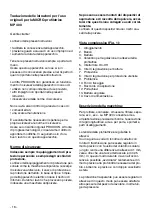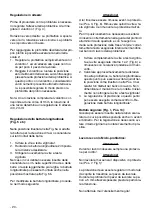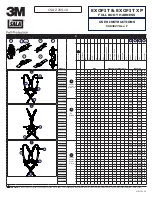
- 11 -
Scope of delivery:
1 pc. Profiling device
2 pcs. Spanners
1 pc. Suction connection
1 pc. Angle stop
3 pc. Collets
Technical Data:
Voltage:
220 - 240 V, 50 Hz, ~
Capacity:
100 watt 10 min
Working speed:
25000 rpm
Dimensions:
340 x 160 x 180 mm
Weight:
approx. 2.6 kg
Tool shank diameter:
up to 3.2 mm
Sound power level:
104 dB(A)
Work piece
height/thickness:
40 mm
You must wear hearing protection
while working!
Only for use in dry rooms
Do not dispose of the electrical device
in the household waste!
Operation:
Before work:
Fastening the profiling device (Fig. 2):
Before beginning work, fasten the profiling de-
vice to a sturdy wood board with the matching
screws.
There are drill holes in the housing bottom of the
device. The wood board can then be fixed to a
table using screw clamps, for example.
Connecting the vacuum cleaner (Fig. 2b):
Caution!
Connect the dust extractor!
It is recommended to always work with dust ex-
traction.
Insert the vacuum hose 1 of the vacuum cleaner
into the connecting piece 2.
Inserting and replacing the profiling tool:
Caution!
For all work described below, it is advisable to
position the height-adjustable safety mechanism
(see Fig. 1, item 7) all the way up. Disconnect
the mains plug!
Inserting the profiling tool:
Caution!
Make sure that the profiler is suitable for speeds
up to 25,000 revolutions per minute.
1. Hold the output shaft 1 (see Fig. 3a) with the
included open-end spanner and use the oth-
er spanner to unscrew and remove the swiv-
el nut 2.
2. Insert the appropriate collet 3 into the open-
ing of the shaft and screw the swivel nut
back on, but do not tighten!
3. Insert the matching profiler 4 (Fig 3b).
4. Tighten the swivel nut as shown in Fig. 3b.
Replacing the tool:
1. As shown in Fig. 3b, loosen the swivel nut,
but do not unscrew it.
2. Remove the profiler 4
3. Insert a new profiler.
4. Re-tighten the swivel nut
Caution!
Please note that the shank diameter must al-
ways correspond to the inside diameter of the
collets! If the collet must be replaced for this rea-
son, then proceed as previously described in “In-
serting the profiling tool”.
Height adjustment:
Before the profiling process, the height of the
profiler must be adjusted. Turn the hand wheel 1
(Fig. 4) to do so.
Turn to the right: profiler moves up, turn to the
left: profiler moves down.
GB












































